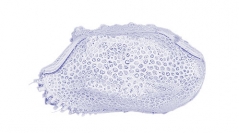

 Comptes Rendus Palevol
23 (11) - Pages 137-159
Comptes Rendus Palevol
23 (11) - Pages 137-159Marine ostracods of the family Bairdiidae Sars, 1888 have an evolutionary history starting from the Ordovician with an explosive diversification of ornate forms during the Triassic. Representatives of the family are notoriously homeomorphic, which makes their taxonomy a major challenge of modern ostracodology. Their classification has thus been problematic since the 1970s. Here we present the first CT-scan investigation of recent and fossil ornate Bairdiidae valves in order to characterize and evaluate the taxonomic significance of unexploited characters, such as pores and pore canals. Thanks to 3D tomography, we explore the distribution of pores at the surface and the pathway of pore canals within the valve wall of the recent genus Triebelina van den Bold, 1946 and the Triassic genera Nodobairdia Kollmann, 1963 and Mirabairdia Kollmann, 1963. In Triebelina indopacifica van den Bold, 1946, we describe an unexpected system of double pore canals, so far unknown in ostracods. We confirm that pore systems in Triebelina have largely intramural positions. In the Triassic Bairdiidae (Nodobairdia mammilata Kollmann, 1963 and Mirabairdia pernodosa Kollmann, 1963), we recognize simple unrimmed and massively nodular pores as well as marginal pores. Lateral normal pores of the Triassic specimens appear to be mostly in intra-solum positions. Although still exploratory and at the limits of the tomographic resolution, these observations provide new evidence to reject the formerly proposed synonymy of Triassic genera with Triebelina, which obstructed the establishment of a phylogenetic classification.
Ostracods, ornate Bairdiidae, morphology, normal pore canals, CT-scan, 3D analysis